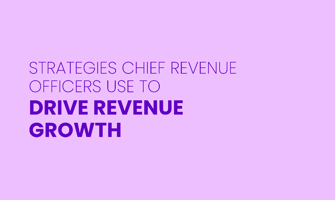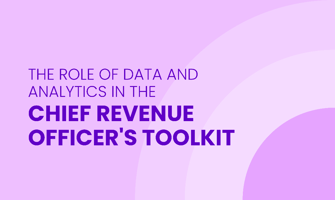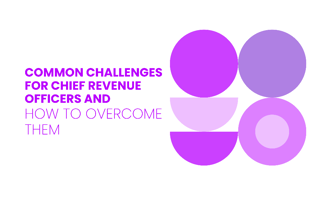Chief Revenue Officers (CROs) employ a multifaceted approach to ensure sustainable growth and...
How Chief Revenue Officers Drive Customer-Centric Strategies
Chief Revenue Officers (CROs) are essential for aligning customer needs with company strategy to drive sustainable revenue growth. Their role in shaping customer-centric strategies ensures that businesses meet evolving customer demands.
This article explores how CROs focus on the customer experience, employing advanced techniques to enhance every touchpoint along the customer journey, from initial acquisition to long-term retention.
You learn about the pivotal role of CROs in fostering loyalty, increasing customer lifetime value, and driving revenue through customer-centric approaches.
Why Chief Revenue Officers are Important to Customer-Centric Strategies?
A customer-centric approach requires coordination across sales, marketing, customer success, and revenue operations. CROs unify these departments, ensuring synchronized efforts.
CROs play a crucial role in understanding and anticipating customer needs and translating these insights into effective strategies. Their leadership ensures every department works together to create a seamless and profitable customer experience.
Also, CROs drive innovation, making sure the organization adapts to evolving customer expectations and market trends.
![]()
Key Strategies for Driving Customer-Centric Strategies
1. Utilizing Predictive Analytics for Personalized Customer Experiences
Predictive analytics involves using historical data and advanced algorithms to forecast future customer behaviors. Predictive analytics is the practice of using data, statistical algorithms, and machine learning techniques to identify the likelihood of future outcomes based on historical data.
This technique helps businesses anticipate customer needs and personalize their experiences accordingly. By utilizing predictive insights, companies can tailor their strategies to enhance customer satisfaction and loyalty.
Benefits
Enhanced Customer Satisfaction: Predictive analytics allows for personalized interactions, meeting customer needs more effectively.
Increased Retention: By anticipating customer behavior, businesses can proactively address potential issues, reducing churn rates. Churn rates refer to the percentage of customers who stop doing business with a company over a specific period.
Practical Implementation
Data Collection and Integration: Gather customer data from various sources such as websites, social media, and customer service interactions. Use data integration platforms to combine this data into a unified view.
Data Analysis: Apply machine learning algorithms to analyze the integrated data. Techniques such as regression analysis and clustering can help identify patterns and trends in customer behavior. Regression analysis is a statistical method used to understand the relationship between different variables and how these relationships influence outcomes.
Predictive Modeling: Develop predictive models using tools like decision trees and neural networks to forecast future customer actions. Decision trees are flowchart-like structures used to make decisions based on input data, while neural networks are computing systems inspired by the human brain's neural networks. These models should be regularly updated with new data to maintain accuracy. Tools like 180ops provide comprehensive solutions for managing and integrating customer data, and enhancing revenue operations through AI and machine learning to drive strategic decision-making.
Implementing Insights: Integrate the insights gained from predictive models into your business strategy by tailoring marketing campaigns, personalizing product recommendations, and enhancing customer service measures to address predicted needs.
2. Implementing Omnichannel Customer Engagement Strategies
An omnichannel strategy ensures a seamless customer experience across all platforms. This approach allows interactions through various channels such as online, mobile, and in-store to be integrated and consistent.
By providing a unified experience, companies can meet customer expectations for convenience and continuity, leading to enhanced customer satisfaction and loyalty.
Benefits
Consistent Customer Experience: Ensures uniform interactions across all customer touchpoints, enhancing satisfaction.
Comprehensive Customer Insights: Provides a holistic view of customer behavior, enabling better strategy formulation.
Practical Implementation
Channel Integration: Utilize middleware solutions and API integrations to connect different customer interaction channels. This ensures that data and experiences are synchronized across platforms. API integrations are interfaces that allow different software systems to communicate and share data seamlessly.
Unified Customer Profile: Create a single, comprehensive view of each customer by merging data from all touchpoints. This can be achieved using customer data platforms that centralize customer data from multiple sources. Customer data platforms are systems designed to collect and integrate customer data from various channels, creating a unified customer profile.
Staff Training: Develop comprehensive training programs for staff to ensure they can manage and operate various channels effectively. Training should cover the use of integrated systems and customer interaction techniques.
Continuous Improvement: Use analytics tools to monitor and assess the performance of your omnichannel strategy regularly. Employ techniques such as A/B testing and customer feedback analysis to refine and enhance the approach continually. A/B testing is a method of comparing two versions of a webpage or app to determine which one performs better.
![]()
3. Employing AI and Machine Learning for Enhanced Customer Support
Artificial Intelligence (AI) and Machine Learning (ML) are revolutionizing customer support by transforming it from a reactive service into a proactive one. These technologies enable Chief Revenue Officers to enhance the responsiveness and personalization of customer interactions.
By leveraging AI and ML, companies can set new standards for customer care, improving both efficiency and customer satisfaction. This transformation allows businesses to address customer needs swiftly and accurately, fostering loyalty and trust.
Benefits
Increased Efficiency: AI and ML can automate the resolution of common inquiries, allowing customer support teams to handle more queries in less time.
Improved Customer Satisfaction: By quickly addressing routine issues, AI and ML free up human agents to focus on more complex problems, leading to higher satisfaction levels.
Practical Implementation
Algorithm Training: Train AI and ML algorithms with large datasets to recognize patterns and predict solutions. This involves using historical customer interaction data to help the systems learn and improve over time. For example, feeding AI models with past customer service records allows them to identify common issues and effective resolutions.
Natural Language Processing (NLP): Implement NLP techniques to enable AI systems to understand and respond to customer queries in natural language. NLP helps in creating chatbots and virtual assistants that can handle basic customer service tasks efficiently. For instance, an NLP-powered chatbot can answer frequently asked questions or direct customers to relevant resources.
Integration with Existing Systems: Ensure that AI and ML tools are integrated with current customer support frameworks. Use APIs (Application Programming Interfaces) to connect these technologies with CRM (Customer Relationship Management) systems and other support platforms. This integration allows for seamless data sharing and enhances the overall efficiency of customer support operations.
Continuous Monitoring and Improvement: Regularly monitor the performance of AI and ML systems and update them with new data to maintain accuracy. Use analytics tools to track their effectiveness, identify areas for improvement, and make necessary adjustments. This ongoing refinement ensures that the AI and ML systems continue to provide high-quality support.
4. Developing Comprehensive Customer Journey Mapping
Customer journey mapping provides a detailed visualization of a customer's interactions with a brand, from initial contact through to post-purchase support. For Chief Revenue Officers, understanding this journey is crucial for identifying opportunities to enhance engagement and improve the customer experience.
By mapping out the customer journey, businesses can pinpoint pain points and optimize every touchpoint. This comprehensive approach ensures that the entire customer experience is seamless and satisfying, ultimately fostering loyalty and increasing lifetime value.
Benefits
Identify Pain Points: Comprehensive journey maps help in pinpointing areas where customers encounter difficulties, enabling businesses to address and resolve these issues.
Inform Strategic Decisions: These maps offer actionable insights that can guide strategic planning and improve overall customer satisfaction and loyalty.
Practical Implementation
Data Collection: Gather data from all customer interaction points, including website visits, social media interactions, purchase history, and customer service contacts. This holistic approach ensures a complete view of the customer journey. Tools like analytics platforms and customer feedback surveys can help in collecting this data effectively.
Cross-Departmental Collaboration: Engage various departments such as marketing, sales, and customer service in the journey mapping process. Collaboration ensures that all relevant data and perspectives are included, leading to a more accurate and comprehensive map.
Visualization Tools: Use journey mapping tools to create visual representations of the customer journey. These tools help in organizing data and highlighting key stages and touchpoints in the journey. Visualization makes it easier to identify patterns and areas for improvement.
Actionable Insights: Analyze the journey maps to identify areas for improvement and opportunities for engagement. Develop strategies based on these insights to enhance the customer experience at every touchpoint. For instance, if the map reveals a frequent drop-off point during the checkout process, the business can streamline this stage to reduce friction and improve conversion rates.
5. Creating Agile and Responsive Feedback Mechanisms
Agile and responsive feedback mechanisms are systems designed to continuously collect and analyze customer feedback, allowing businesses to adapt quickly to changing customer needs and preferences. These mechanisms enable Chief Revenue Officers to understand customer sentiment and use real-time data to drive continuous improvement.
By engaging actively with customers, businesses can foster trust and demonstrate a commitment to excellence, ensuring they remain attuned to customer expectations.
Benefits
Build Trust: Engaging with customers through feedback helps to build trust and shows a commitment to excellence.
Quick Adaptation: Provides a direct line to the voice of the customer, enabling quick adaptation to their evolving needs and enhancing the overall customer experience.
Practical Implementation
Multiple Feedback Channels: Establish various touchpoints for gathering customer opinions, such as online surveys, in-app feedback forms, social media monitoring, and direct communication channels like email and chat. This approach ensures comprehensive feedback from different customer segments and interactions.
Real-Time Monitoring: Utilize tools for real-time monitoring and analysis of feedback. Implement technologies that integrate social media listening, sentiment analysis, and live feedback dashboards. These tools can provide instant insights into customer sentiment and highlight areas that need immediate attention.
Data Analytics for Actionable Insights: Analyze the collected feedback using advanced data analytics techniques such as text mining, sentiment analysis, and trend analysis. These techniques help in identifying patterns and areas for improvement. Convert the insights gained into actionable strategies that can inform business decisions and enhance customer experiences.
Feedback Integration into Company Culture: Foster a company culture that values and acts upon customer input. Encourage employees at all levels to consider customer feedback in their decision-making processes. Regularly share feedback insights with teams through internal communications and meetings to keep everyone aligned with customer needs. Create a feedback loop where employees see the impact of their actions on customer satisfaction, reinforcing the importance of customer-centric practices.
6. Adopting Real-Time Customer Insights for Immediate Action
Real-time customer insights involve the continuous monitoring and analysis of customer data as it is generated. This allows businesses to make swift adjustments to strategies and respond immediately to customer needs and behaviors. The ability to act quickly on fresh data provides a significant competitive advantage.
By utilizing real-time data, companies can maintain a dynamic and responsive relationship with their customers, ensuring their needs are met as they arise.
Benefits
Stronger Customer Retention: The immediacy of real-time insights often leads to stronger customer retention as businesses can address issues promptly.
Competitive Advantage: Fosters a culture of responsiveness, allowing companies to capitalize on opportunities and differentiate themselves in a crowded marketplace.
Practical Implementation
Invest in Real-Time Analytics Tools: Implement technology platforms that allow for the continuous monitoring and analysis of customer data. Real-time analytics tools and dashboards provide immediate visibility into customer interactions and behaviors. These tools help in capturing and processing data efficiently, enabling quick decision-making.
Data Integration Techniques: Integrate customer data from various sources into a unified system. Use data integration techniques such as data warehousing and ETL (Extract, Transform, Load) processes to combine data from different channels, both online and offline. This holistic view enables accurate and timely insights into customer behavior, providing a comprehensive understanding necessary for immediate action.
Train Teams for Data-Driven Decisions: Ensure that teams are trained in data-driven decision-making to respond effectively to real-time insights. Training should include interpreting data, understanding customer behavior, and implementing quick adjustments based on insights. This preparation ensures that teams can act swiftly and accurately on real-time data, enhancing the overall customer experience.
![]()
Conclusion
For driving customer-centric strategies, CROs are employing predictive analytics, embracing omnichannel engagement, deploying AI and ML in support services, mapping the customer journey, fostering agile feedback mechanisms, and leveraging real-time insights. These efforts ensure that the customer is always at the center of the business model.
Focusing on customer needs helps turn casual users into loyal advocates, leading to sustainable revenue growth. As the role of the CRO continues to evolve, these strategies will define the customer experience and the success of the business.
Maintaining a strong focus on customer needs is essential for driving business growth and building lasting customer relationships.
FAQs
What are the best practices for a CRO to improve customer retention and reduce churn in a B2B SaaS environment?
To improve customer retention and reduce churn, CROs should implement personalized engagement strategies, focus on effective onboarding, and regularly measure CX metrics. By enhancing the customer experience and addressing pain points early, CROs can ensure a higher customer lifetime value and foster sustainable growth.
How can a CRO effectively drive sustainable growth and profitability in a B2B SaaS company?
CROs can drive sustainable growth and profitability by aligning revenue operations, leveraging up-sales and cross-sales opportunities, and optimizing base renewals. They should focus on developing a comprehensive revenue strategy that incorporates customer acquisition, lead generation, and referral marketing to build a robust revenue stream.
What qualities make an effective CRO leader in the context of revenue generation and management?
An effective CRO leader should have strong strategic thinking, excellent communication skills, and a deep understanding of revenue-generating departments. They should be proficient in sales management, possess niche knowledge in B2B sales, and be adept at aligning various C-suite stakeholders to drive a unified revenue strategy.
Why is it important for CROs to focus on sign-up and onboarding processes for customer acquisition?
Focusing on sign-up and onboarding processes is critical for CROs because these initial stages set the tone for customer satisfaction and retention. Effective onboarding can significantly enhance the customer experience, leading to higher retention rates, improved customer lifetime value, and increased retention revenue.
How can CROs utilize referrals and referral marketing to enhance revenue streams and customer acquisition?
CROs can enhance revenue streams and customer acquisition by implementing effective referral marketing strategies. Encouraging satisfied customers to refer new clients through incentivized programs can lead to cost-effective growth. This approach not only boosts sign-up rates but also strengthens the overall customer base and drives sustainable growth.




